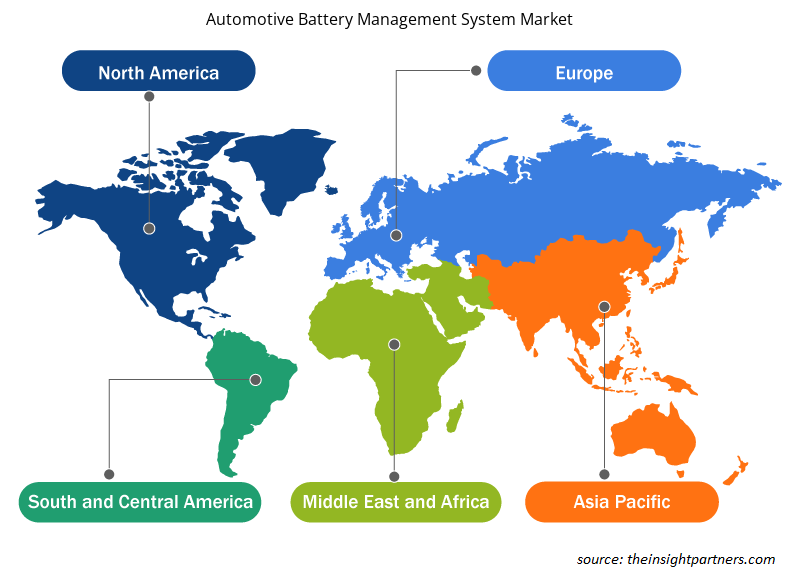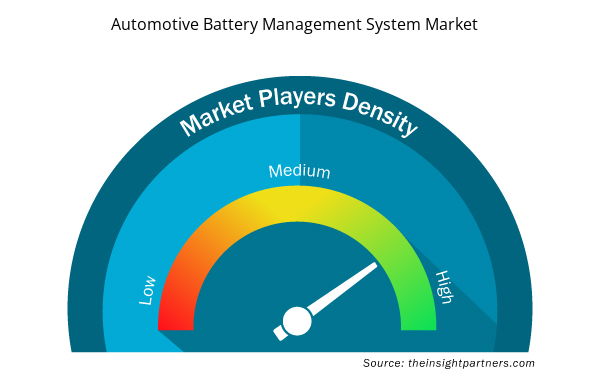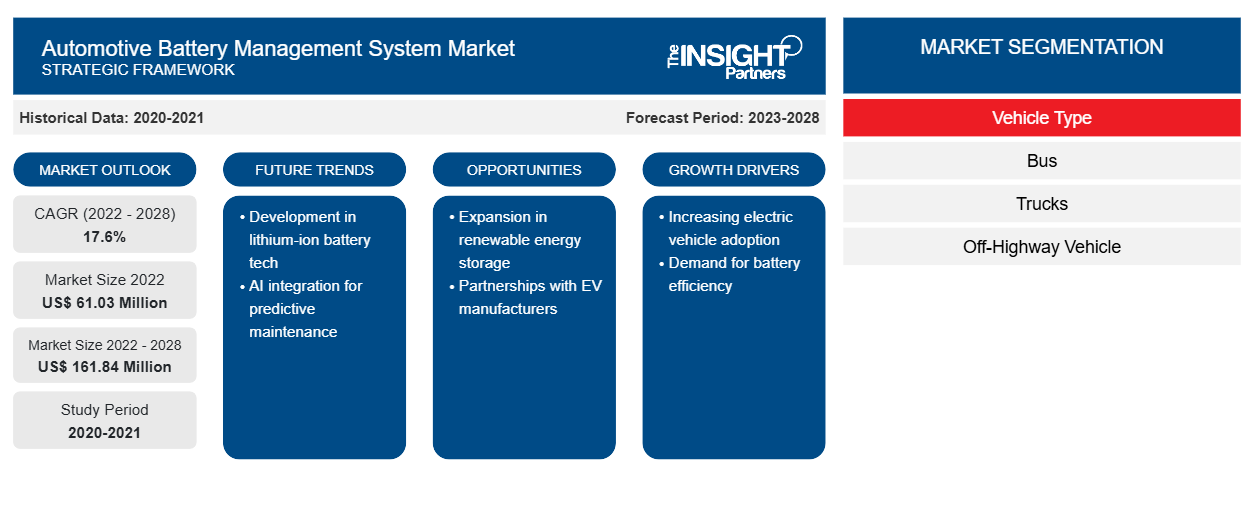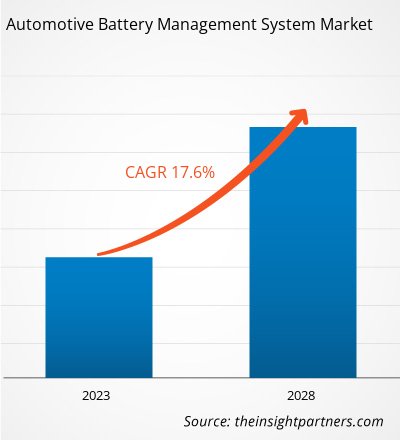Der Markt für Batteriemanagementsysteme für Kraftfahrzeuge soll voraussichtlich von 61,03 Millionen US-Dollar im Jahr 2022 wachsen; von 2022 bis 2028 wird eine durchschnittliche jährliche Wachstumsrate (CAGR) von 17,6 % erwartet.
Ein Batteriemanagementsystem verwaltet Batterien, die in Hochspannungs-Hybrid- und Elektrofahrzeugen verwendet werden. Hersteller von Elektrofahrzeugen und Batteriepacks integrieren ein Batteriemanagementsystem in Lithium-Ionen-Batterien, um das Batteriepack zu schützen. Das gesamte Batteriesystem in einem Elektrofahrzeug ist eine Kombination aus mehreren Komponenten wie Batteriemodulen, Sensoren, Steuerungen, Wärmemanagementsystemen und Batteriemanagementsystemen. Angesichts der zunehmenden Besorgnis hinsichtlich des Umweltschutzes und der positiven Initiativen der Regierungen zur Emissionsreduzierung wird erwartet, dass die Nachfrage nach Elektro- und Hybridfahrzeugen im Prognosezeitraum von 2022 bis 2028 in beeindruckendem Tempo wachsen wird. Dies wiederum wird das Wachstum des Marktes für Batteriemanagementsysteme für Kraftfahrzeuge ankurbeln .
Die globale Elektrofahrzeug- und Batteriepackbranche ist durch die Präsenz einiger sehr bekannter und finanzkräftiger Unternehmen wie Mitsubishi, Nissan und Tesla gekennzeichnet. Aus diesem Grund ist die Verhandlungsmacht der Käufer auf dem Markt für Batteriemanagementsysteme für Kraftfahrzeuge recht hoch. Aufgrund der kontinuierlichen Forschung und Entwicklung im Bereich der Elektrofahrzeuge in Verbindung mit dem schnellen Wachstum des Marktes für Batteriemanagementsysteme für Kraftfahrzeuge wird die Verhandlungsmacht der Käufer zwischen 2019 und 2027 voraussichtlich hoch bleiben. Die großen Unternehmen auf dem Markt für Batteriemanagementsysteme für Kraftfahrzeuge verwenden unterschiedliche Strategien bei der Planung von Batteriesystemen für ihre Fahrzeuge. Kontinuierliche Fortschritte im Technologiesektor werden voraussichtlich Druck auf die Anbieter von Batteriemanagementsystemen ausüben, sich an die Änderungen anzupassen, um ihre Marktposition zu behaupten. Aus diesem Grund neigen Käufer auch stark dazu, im Laufe der Zeit den BMS-Anbieter zu wechseln, je nach ihren spezifischen Anforderungen und dem Technologieportfolio der BMS-Anbieter.
Passen Sie diesen Bericht Ihren Anforderungen an
Sie erhalten kostenlose Anpassungen an jedem Bericht, einschließlich Teilen dieses Berichts oder einer Analyse auf Länderebene, eines Excel-Datenpakets sowie tolle Angebote und Rabatte für Start-ups und Universitäten.
- Holen Sie sich die wichtigsten Markttrends aus diesem Bericht.Dieses KOSTENLOSE Beispiel umfasst eine Datenanalyse von Markttrends bis hin zu Schätzungen und Prognosen.
Auswirkungen der COVID-19-Pandemie auf den Marktanteil von Batteriemanagementsystemen für Kraftfahrzeuge
Der COVID-19-Ausbruch hatte auf seinem Höhepunkt im Jahr 2020 dramatische Auswirkungen auf die Weltwirtschaft und behinderte die Geschäftstätigkeit in der Fertigungsindustrie. Vor dem Ausbruch erlebte der Marktanteil von Batteriemanagementsystemen für Kraftfahrzeuge ein erhebliches Wachstum aufgrund gestiegener Verkäufe von Elektrofahrzeugen, eines gestiegenen verfügbaren Einkommens und einer einfachen Verfügbarkeit von Krediten und Finanzierungen. Darüber hinaus treiben erhebliche Investitionsinitiativen in die Entwicklung von Elektrofahrzeugen die Nachfrage nach Batteriemanagementsystemen für Kraftfahrzeuge an. Laut dem International Council on Clean Transportation erreichten die weltweiten Verkäufe von Elektrofahrzeugen im Jahr 2021 einen Rekordwert von 6,9 Millionen, ein Anstieg von 107 % gegenüber 2020. Der Ausbruch der COVID-19-Pandemie verlangsamte jedoch die Investitionen in und die Produktion von Elektrofahrzeugen. In den ersten Tagen der Pandemie schränkte die Krise alle Geschäftsabschlüsse, Kooperationen und Partnerschaften, die den Markt für Batteriemanagementsysteme für Kraftfahrzeuge störten, erheblich ein. Der Ausbruch der Pandemie behinderte den Fahrzeugabsatz im Februar 2020; außerdem gingen die Verkäufe in den USA bis April um 47 % und in Europa um 80 % zurück. Einem Bericht von Statista zufolge sanken die weltweiten Autoverkäufe im Jahr 2020 auf 63,8 Millionen und verzeichneten im Jahr 2021 mit 66 Millionen Verkäufen eine langsame Erholung.
Markteinblick – Markt für Batteriemanagementsysteme für Kraftfahrzeuge
Steigende Verkäufe von Elektrofahrzeugen und Ausbau der Infrastruktur für Elektrofahrzeuge
Die Verkäufe von Elektrofahrzeugen (EV) wachsen aufgrund zunehmender Bedenken hinsichtlich des Umweltschutzes und staatlicher Maßnahmen, die die Einführung emissionsarmer und emissionsfreier Fahrzeuge fördern, rasant. Von Regierungen angebotene Subventionen und Steuervergünstigungen ermutigen Hersteller, ihre Prozesse zu skalieren. Laut Global Electric Vehicle Outlook erreichten die Verkäufe von Elektroautos, einschließlich vollelektrischer und Plug-in-Hybridfahrzeuge, im Jahr 2021 6,6 Millionen Einheiten. Im selben Jahr stiegen die Verkäufe in China auf 3,3 Millionen, was etwa der Hälfte der weltweiten Verkäufe entspricht. Darüber hinaus stiegen die EV-Verkäufe in Europa um 65 % auf 2,3 Millionen Einheiten, während sich die Verkäufe in den USA im Jahr 2021 auf 630.000 Einheiten verdoppelten. Eine Erhöhung der Investitionen in die Ladeinfrastruktur und eine Zunahme günstiger staatlicher Maßnahmen treiben also die Batterieproduktion voran und stärken damit die Nachfrage nach Batteriemanagementsystemen für Kraftfahrzeuge.
Fahrzeugtypbasierte Erkenntnisse
Basierend auf dem Fahrzeugtyp ist der Markt für Batteriemanagementsysteme für Kraftfahrzeuge in Busse, Lastwagen und Geländefahrzeuge unterteilt. Im Jahr 2022 hatte das Bussegment den größten Anteil am Markt für Batteriemanagementsysteme für Kraftfahrzeuge, da zunehmend Batterien in Bussen eingesetzt werden, um die CO2-Emissionen zu reduzieren. Darüber hinaus wird erwartet, dass das LKW-Segment im Prognosezeitraum die höchste durchschnittliche jährliche Wachstumsrate verzeichnet. Die Nachfrage der Hersteller von Elektrobussen nach Batteriemanagementsystemen steigt aufgrund wachsender Initiativen für eine optimale Batterieleistung und Überwachung der Batteriepacktemperatur erheblich an. Darüber hinaus steigt in verschiedenen Ländern auch der Bedarf an elektrischen Schulbussen, um die Karbonisierung zu reduzieren, was es den Herstellern von elektrischen Schulbussen auch ermöglicht, ihre Produktionslinien zu erweitern. Mehrere Regierungen verschiedener Länder setzen auf Busse mit umweltfreundlicher Technologie, was die Nachfrage nach elektrischen Reisebussen ankurbelt und somit das Wachstum des Marktes für Batteriemanagementsysteme für Kraftfahrzeuge fördert.
Regionale Einblicke in den Markt für Batteriemanagementsysteme für Kraftfahrzeuge
Die regionalen Trends und Faktoren, die den Markt für Batteriemanagementsysteme für Kraftfahrzeuge im gesamten Prognosezeitraum beeinflussen, wurden von den Analysten von Insight Partners ausführlich erläutert. In diesem Abschnitt werden auch die Marktsegmente und die Geografie von Batteriemanagementsystemen für Kraftfahrzeuge in Nordamerika, Europa, im asiatisch-pazifischen Raum, im Nahen Osten und Afrika sowie in Süd- und Mittelamerika erörtert.

- Erhalten Sie regionale Daten zum Markt für Batteriemanagementsysteme für Kraftfahrzeuge
Umfang des Marktberichts zum Batteriemanagementsystem für Kraftfahrzeuge
| Berichtsattribut | Details |
|---|---|
| Marktgröße im Jahr 2022 | 61,03 Millionen US-Dollar |
| Marktgröße bis 2028 | 161,84 Millionen US-Dollar |
| Globale CAGR (2022 - 2028) | 17,6 % |
| Historische Daten | 2020-2021 |
| Prognosezeitraum | 2023–2028 |
| Abgedeckte Segmente | Nach Fahrzeugtyp
|
| Abgedeckte Regionen und Länder | Nordamerika
|
| Marktführer und wichtige Unternehmensprofile |
|
Dichte der Marktteilnehmer für Batteriemanagementsysteme für Kraftfahrzeuge: Die Auswirkungen auf die Geschäftsdynamik verstehen
Der Markt für Batteriemanagementsysteme für Kraftfahrzeuge wächst rasant. Dies wird durch die steigende Nachfrage der Endnutzer aufgrund von Faktoren wie sich entwickelnden Verbraucherpräferenzen, technologischen Fortschritten und einem größeren Bewusstsein für die Vorteile des Produkts vorangetrieben. Mit der steigenden Nachfrage erweitern Unternehmen ihr Angebot, entwickeln Innovationen, um die Bedürfnisse der Verbraucher zu erfüllen, und nutzen neue Trends, was das Marktwachstum weiter ankurbelt.
Die Marktteilnehmerdichte bezieht sich auf die Verteilung der Firmen oder Unternehmen, die in einem bestimmten Markt oder einer bestimmten Branche tätig sind. Sie gibt an, wie viele Wettbewerber (Marktteilnehmer) in einem bestimmten Marktraum im Verhältnis zu seiner Größe oder seinem gesamten Marktwert präsent sind.
Die wichtigsten Unternehmen auf dem Markt für Batteriemanagementsysteme für Kraftfahrzeuge sind:
- CONTINENTAL AG
- DANA LIMITED
- GENTHERM
- HANON-SYSTEME
- MAHLLE GMBH
Haftungsausschluss : Die oben aufgeführten Unternehmen sind nicht in einer bestimmten Reihenfolge aufgeführt.

- Überblick über die wichtigsten Akteure auf dem Markt für Batteriemanagementsysteme für Kraftfahrzeuge
Die Akteure auf dem Markt für Batteriemanagementsysteme für Kraftfahrzeuge konzentrieren sich hauptsächlich auf die Entwicklung fortschrittlicher und effizienter Produkte.
- Im August 2021 gaben der Batterieexperte Varta und der Entwicklungs- und Produktionsdienstleister Continental Engineering Services (CES) ihre Zusammenarbeit bekannt. Im Rahmen eines ersten Pilotprojekts entwickelten die beiden Partner gemeinsam ein austauschbares 48-Volt-Batteriepaket für elektrisch angetriebene Zweiräder mit einer Leistung von 10 kW und mehr.
- Im Juni 2021 gab Carrar, ein israelisches Unternehmen, das hochwertige Wärmemanagementsysteme für den Elektromobilitätssektor entwickelt, bekannt, dass Gentherm, ein Marktführer und Entwickler hochmoderner Wärmemanagementlösungen, der Hauptinvestor einer Seed-Finanzierungsrunde ist.
Der Markt für Batteriemanagementsysteme für Kraftfahrzeuge ist in fünf große Regionen unterteilt: Nordamerika, Europa, Asien-Pazifik (APAC) und Rest der Welt. Im Jahr 2022 war der asiatisch-pazifische Raum mit einem beträchtlichen Umsatzanteil Marktführer, gefolgt von Europa. Darüber hinaus wird erwartet, dass der asiatisch-pazifische Raum von 2022 bis 2028 die höchste durchschnittliche jährliche Wachstumsrate (CAGR) auf dem Markt verzeichnet.
Continental AG; Dana Limited; GENTHERM; Hanon Systems; Mahle GmbH; NXP Semiconductors; Renesas Electronics Corporation; Robert Bosch GmbH; Valeo; und Marelli Holdings Co., Ltd. gehören zu den wichtigsten Akteuren auf dem Markt für Batteriemanagementsysteme für Kraftfahrzeuge. Der Marktbericht bietet detaillierte Markteinblicke, die den wichtigsten Akteuren dabei helfen, das Wachstum in den kommenden Jahren strategisch zu planen.
- Historische Analyse (2 Jahre), Basisjahr, Prognose (7 Jahre) mit CAGR
- PEST- und SWOT-Analyse
- Marktgröße Wert/Volumen – Global, Regional, Land
- Branche und Wettbewerbsumfeld
- Excel-Datensatz


- Intradermal Injection Market
- Electronic Data Interchange Market
- Quantitative Structure-Activity Relationship (QSAR) Market
- Bioremediation Technology and Services Market
- Environmental Consulting Service Market
- Hydrogen Compressors Market
- Retinal Imaging Devices Market
- Micro-Surgical Robot Market
- Gas Engine Market
- Customer Care BPO Market

Report Coverage
Revenue forecast, Company Analysis, Industry landscape, Growth factors, and Trends

Segment Covered
This text is related
to segments covered.

Regional Scope
North America, Europe, Asia Pacific, Middle East & Africa, South & Central America

Country Scope
This text is related
to country scope.
Häufig gestellte Fragen
Increasing Sales of EVs and Expansion of EV Infrastructure driving the need for Automotive Battery Management System market. Electric vehicle (EV) sales are growing at a fast pace owing to increasing concerns about environmental protection and government policies favoring the adoption of low-emission and zero-emission vehicles. Subsidies and tax rebates offered by governments encourage manufacturers to scale up their processes.
Wireless Automotive Battery Management System is propelling the market growth. A large amount of wiring goes into an EV to connect individual cells in a battery pack, and these wires are liable to safety failures. Wireless connectivity results in high reliability, reduced costs, and decreased weight in large multicell battery packs. Wireless connections are also allowing EV manufacturers to experiment with the placement of flexible battery modules and the installation of additional sensors in the place of wires. Wireless technologies such as Zigbee and point-to-point wireless topology are being used to enable wireless battery management systems.
Asia Pacific is the fastest growing regional market, followed by North America.
Mexico and India are expected to register high growth rates during the forecast period.
The key players, holding majority shares, in Automotive Battery Management System market includes Continental AG; Dana Limited; GENTHERM; Hanon Systems; and Mahle GmbH.
The US held the largest market share in 2022, followed by China.
The incremental growth, expected to be recorded for the Automotive Battery Management System market during the forecast period, is US$ 100.81 million.
The global Automotive Battery Management System market was estimated to be US$ 61.03 million in 2022 and is expected to grow at a CAGR of 17.6%, during the forecast period 2022 - 2028.
Trends and growth analysis reports related to Energy and Power : READ MORE..
The List of Companies - Automotive Battery Management System Market
- CONTINENTAL AG
- DANA LIMITED
- GENTHERM
- HANON SYSTEMS
- MAHLE GMBH
- NXP SEMICONDUCTORS
- RENESAS ELECTRONICS CORPORATION
- ROBERT BOSCH GMBH
- VALEO
- MARELLI HOLDINGS CO., LTD
The Insight Partners performs research in 4 major stages: Data Collection & Secondary Research, Primary Research, Data Analysis and Data Triangulation & Final Review.
- Data Collection and Secondary Research:
As a market research and consulting firm operating from a decade, we have published and advised several client across the globe. First step for any study will start with an assessment of currently available data and insights from existing reports. Further, historical and current market information is collected from Investor Presentations, Annual Reports, SEC Filings, etc., and other information related to company’s performance and market positioning are gathered from Paid Databases (Factiva, Hoovers, and Reuters) and various other publications available in public domain.
Several associations trade associates, technical forums, institutes, societies and organization are accessed to gain technical as well as market related insights through their publications such as research papers, blogs and press releases related to the studies are referred to get cues about the market. Further, white papers, journals, magazines, and other news articles published in last 3 years are scrutinized and analyzed to understand the current market trends.
- Primary Research:
The primarily interview analysis comprise of data obtained from industry participants interview and answers to survey questions gathered by in-house primary team.
For primary research, interviews are conducted with industry experts/CEOs/Marketing Managers/VPs/Subject Matter Experts from both demand and supply side to get a 360-degree view of the market. The primary team conducts several interviews based on the complexity of the markets to understand the various market trends and dynamics which makes research more credible and precise.
A typical research interview fulfils the following functions:
- Provides first-hand information on the market size, market trends, growth trends, competitive landscape, and outlook
- Validates and strengthens in-house secondary research findings
- Develops the analysis team’s expertise and market understanding
Primary research involves email interactions and telephone interviews for each market, category, segment, and sub-segment across geographies. The participants who typically take part in such a process include, but are not limited to:
- Industry participants: VPs, business development managers, market intelligence managers and national sales managers
- Outside experts: Valuation experts, research analysts and key opinion leaders specializing in the electronics and semiconductor industry.
Below is the breakup of our primary respondents by company, designation, and region:

Once we receive the confirmation from primary research sources or primary respondents, we finalize the base year market estimation and forecast the data as per the macroeconomic and microeconomic factors assessed during data collection.
- Data Analysis:
Once data is validated through both secondary as well as primary respondents, we finalize the market estimations by hypothesis formulation and factor analysis at regional and country level.
- Macro-Economic Factor Analysis:
We analyse macroeconomic indicators such the gross domestic product (GDP), increase in the demand for goods and services across industries, technological advancement, regional economic growth, governmental policies, the influence of COVID-19, PEST analysis, and other aspects. This analysis aids in setting benchmarks for various nations/regions and approximating market splits. Additionally, the general trend of the aforementioned components aid in determining the market's development possibilities.
- Country Level Data:
Various factors that are especially aligned to the country are taken into account to determine the market size for a certain area and country, including the presence of vendors, such as headquarters and offices, the country's GDP, demand patterns, and industry growth. To comprehend the market dynamics for the nation, a number of growth variables, inhibitors, application areas, and current market trends are researched. The aforementioned elements aid in determining the country's overall market's growth potential.
- Company Profile:
The “Table of Contents” is formulated by listing and analyzing more than 25 - 30 companies operating in the market ecosystem across geographies. However, we profile only 10 companies as a standard practice in our syndicate reports. These 10 companies comprise leading, emerging, and regional players. Nonetheless, our analysis is not restricted to the 10 listed companies, we also analyze other companies present in the market to develop a holistic view and understand the prevailing trends. The “Company Profiles” section in the report covers key facts, business description, products & services, financial information, SWOT analysis, and key developments. The financial information presented is extracted from the annual reports and official documents of the publicly listed companies. Upon collecting the information for the sections of respective companies, we verify them via various primary sources and then compile the data in respective company profiles. The company level information helps us in deriving the base number as well as in forecasting the market size.
- Developing Base Number:
Aggregation of sales statistics (2020-2022) and macro-economic factor, and other secondary and primary research insights are utilized to arrive at base number and related market shares for 2022. The data gaps are identified in this step and relevant market data is analyzed, collected from paid primary interviews or databases. On finalizing the base year market size, forecasts are developed on the basis of macro-economic, industry and market growth factors and company level analysis.
- Data Triangulation and Final Review:
The market findings and base year market size calculations are validated from supply as well as demand side. Demand side validations are based on macro-economic factor analysis and benchmarks for respective regions and countries. In case of supply side validations, revenues of major companies are estimated (in case not available) based on industry benchmark, approximate number of employees, product portfolio, and primary interviews revenues are gathered. Further revenue from target product/service segment is assessed to avoid overshooting of market statistics. In case of heavy deviations between supply and demand side values, all thes steps are repeated to achieve synchronization.
We follow an iterative model, wherein we share our research findings with Subject Matter Experts (SME’s) and Key Opinion Leaders (KOLs) until consensus view of the market is not formulated – this model negates any drastic deviation in the opinions of experts. Only validated and universally acceptable research findings are quoted in our reports.
We have important check points that we use to validate our research findings – which we call – data triangulation, where we validate the information, we generate from secondary sources with primary interviews and then we re-validate with our internal data bases and Subject matter experts. This comprehensive model enables us to deliver high quality, reliable data in shortest possible time.


 Holen Sie sich ein kostenloses Muster für diesen Bericht
Holen Sie sich ein kostenloses Muster für diesen Bericht